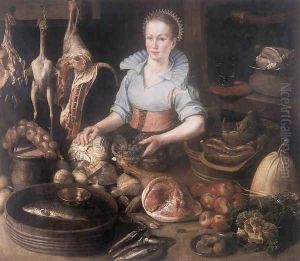Pieter Cornelisz van Ryck Paintings
Pieter Cornelisz van Rijck, also known as Pieter Cornelisz van Ryck, was a Dutch painter active during the early 17th century, born in 1568. He is primarily known for his still life paintings which often featured kitchen scenes and market displays that were popular in Northern Europe during that time. His work is characterized by a meticulous attention to detail and a keen interest in portraying everyday objects with a sense of realism and texture.
Van Ryck was born in the Dutch Republic, a country that was experiencing a great deal of economic prosperity and cultural growth during his lifetime. This period, known as the Dutch Golden Age, was marked by a flourishing of the arts, science, trade, and the power of the Dutch East India Company. However, there is not a wealth of information available about van Ryck's personal life or training. It is believed that he may have been a student of the Haarlem painter Cornelis Corneliszoon van Haarlem, who was a prominent Northern Mannerist artist at the time.
Throughout his career, Pieter Cornelisz van Ryck produced artworks that were reflective of the tastes and interests of the burgeoning middle class in the Netherlands. His still lifes often included a variety of objects such as game, fish, fruits, and vegetables, as well as domestic items like pewter plates, glassware, and textiles. These paintings not only demonstrated his skill in rendering different textures and surfaces but also served as a form of documentation of the diverse goods that were available in the Dutch markets, including exotic imports from Asia and the Americas.
While van Ryck's work was well-received during his lifetime, he did not gain the same level of fame as some of his contemporaries, such as Willem Claesz. Heda or Pieter Claesz. Nonetheless, his paintings have been appreciated for their contribution to the development of the still life genre in the Netherlands. Pieter Cornelisz van Ryck died in 1631. Today, his paintings can occasionally be found in art museums and private collections, offering a window into the domestic and commercial life of the 17th-century Dutch Republic.
